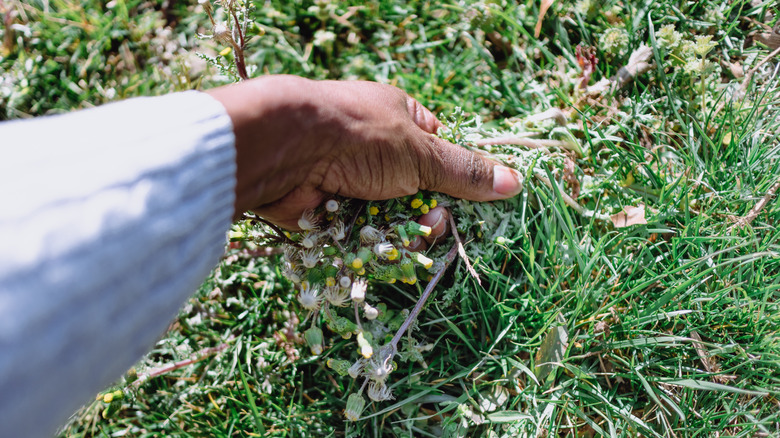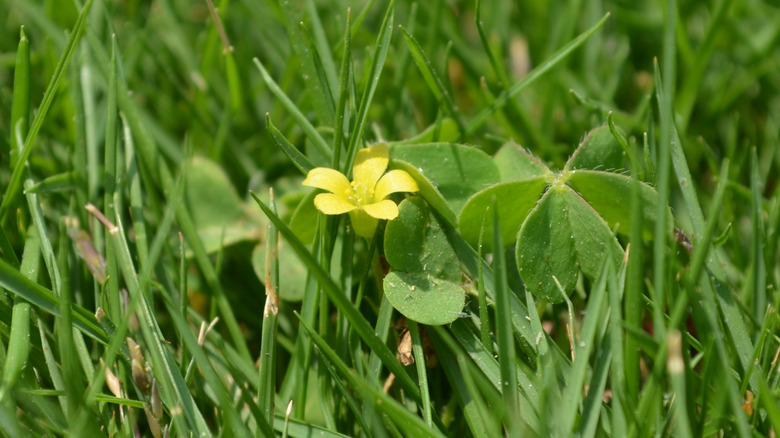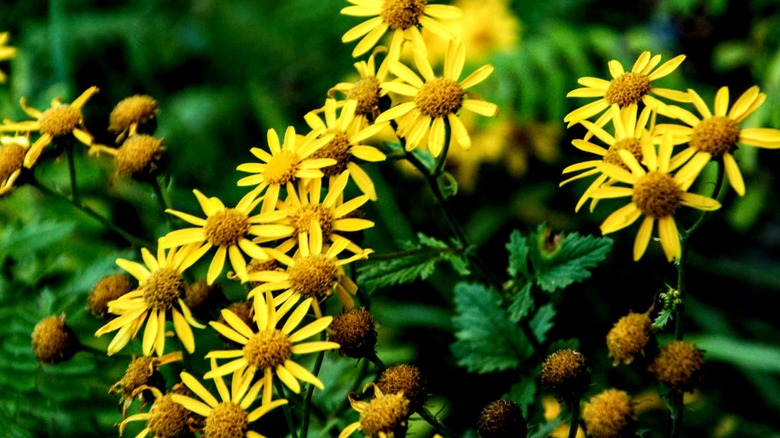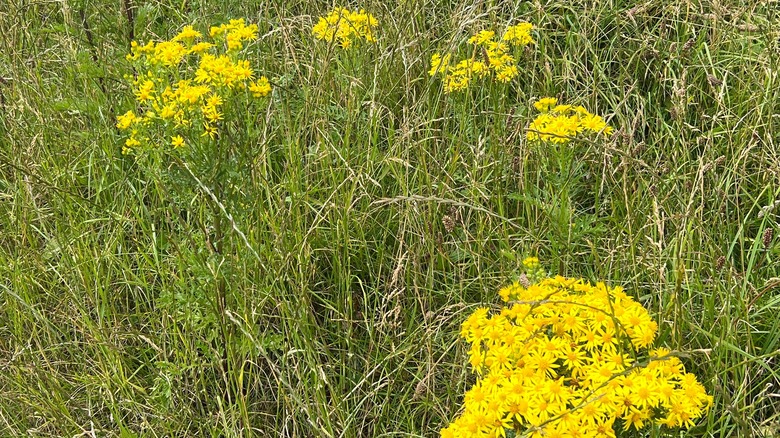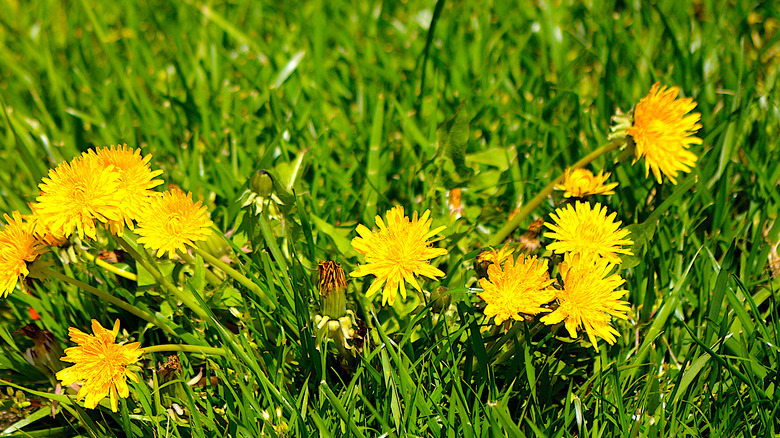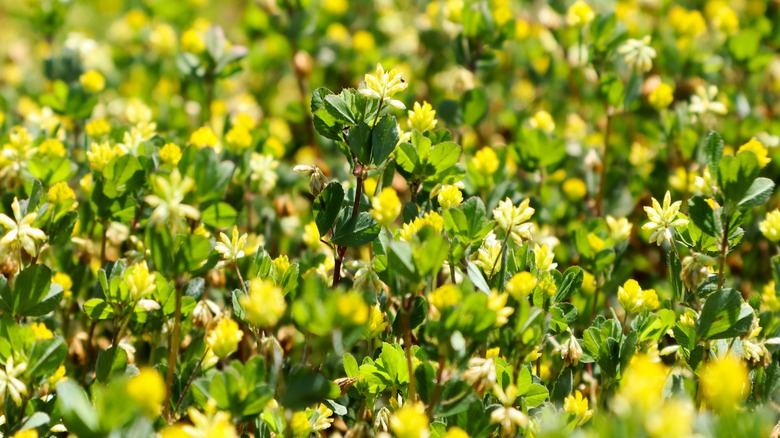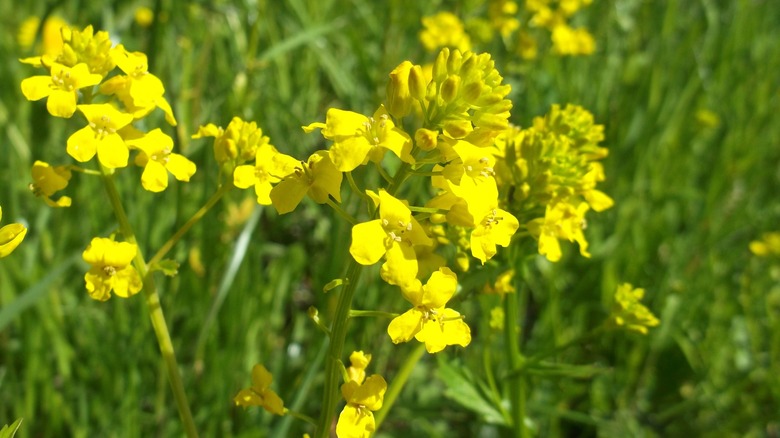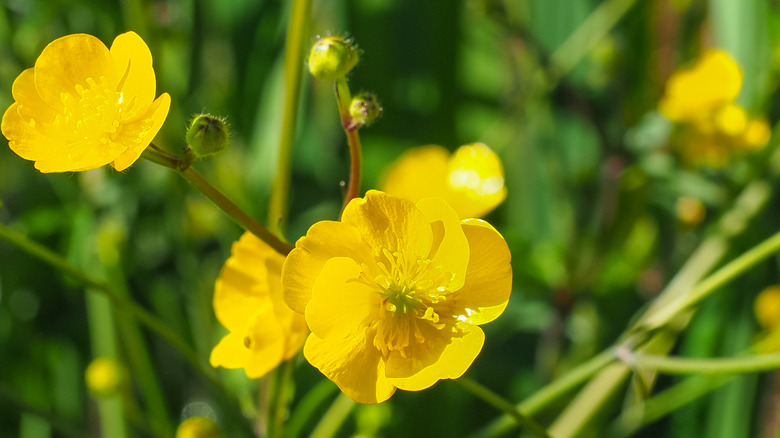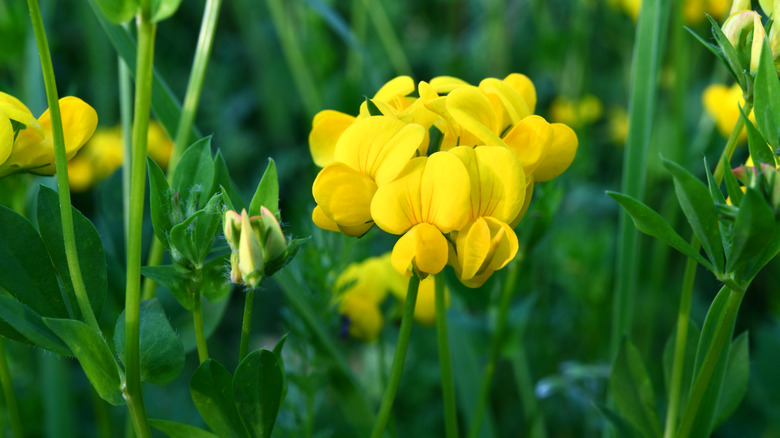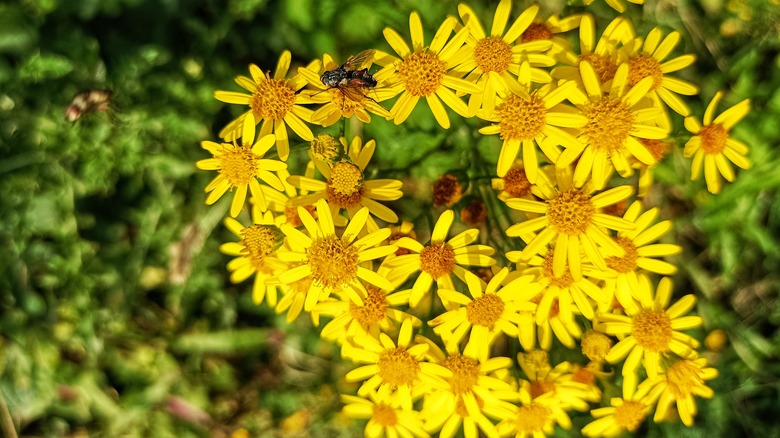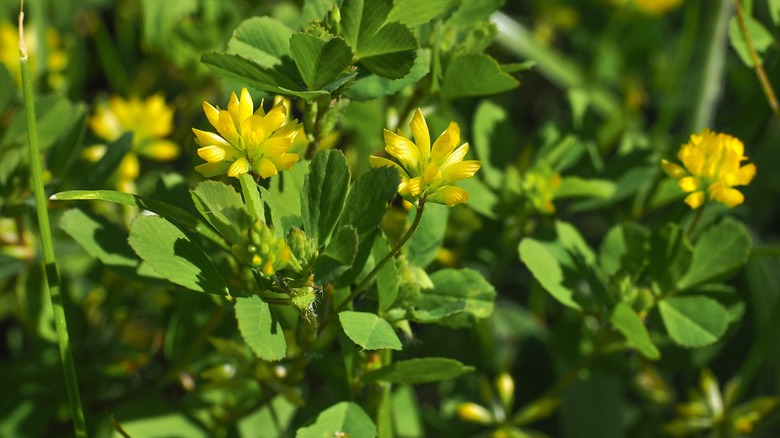Common Types Of Yellow Weeds In Your Lawn & Which Are Invasive
We may receive a commission on purchases made from links.
Eagle-eyed gardeners might have noticed that most garden weeds produce yellow flowers. This may have something to do with the fact that insects prefer yellow flowers, further enhancing the weed's chance to be pollinated, reproduce, and spread. When it comes to weeds in the lawn, though, one thing is for sure: they are as unwelcome as a stone in your shoe. However, not all weeds are as troublesome as others, and it's important to understand the terminology used to describe various species. This helps you to follow the correct methods for eliminating the pesky weeds while keeping your family and pets safe. Undesirable plants can be considered as weeds, noxious weeds, or invasive weeds. A weed is a plant that creates problems where it is growing, while a noxious weed is a plant that an authority has classified as posing the risk of injury to the public or local area. An invasive weed is a non-native plant that invades and overwhelms an area.
Invasive weeds are usually aggressive, possessing qualities that enable them to spread and grow vigorously. Because of this, you need to act quickly and eradicate them. Luckily, there are various tactics you can use to get rid of them and prevent future growth. The way you manage a lawn weed will depend on which one it is, as each species will respond to different methods. Common yellow-flowering weeds you might find in the lawn include the non-invasive dandelion which can be managed by encouraging a dense and healthy lawn, and the invasive birdsfoot trefoil which can be removed by hand or mowed on a low setting. Here is a list of common types of yellow weeds in your yard, which are invasive, and how to remove them.
Non-invasive yellow woodsorrel spreads aggressively with explosive seeds
Yellow woodsorrel (Oxalis stricta) is a common perennial weed that is predominantly found in the eastern portion of the U.S. and Canada, though it exists across 46 states. It is widespread in grassy areas like lawns, fields, woods, and garden borders. The dainty-looking plant produces deep lemon-colored flowers from May to September, and fresh green heart-shaped foliage with purplish stems. It is not invasive but it spreads aggressively via seeds that follow the flowers. Held in capsules atop erect stems, thousands of seeds are dispersed far and wide by a single plant when they ripen and subsequently explode. Thrown a distance of up to 12 feet, these weeds can soon become a serious problem across your whole lawn if they are not properly managed.
There are various ways to control woodsorrel in your lawn, but ultimately your aim should be to create a dense and healthy turf that will limit the weed's ability to spread and thrive. This can be achieved with proper watering and fertilizing practices. To resolve the immediate issue, hand-pulling small patches of yellow woodsorrel from the lawn works well. The weeds have shallow root systems so they don't take much effort, and this can be made even easier if the soil is moist. Be sure to remove the whole root system, including the rhizomes, to prevent reappearances. Since this weed spreads rapidly via seeds, it should always be managed before flowers have the chance to form.
Non-invasive butterweed is toxic to animals
Butterweed (Packera glabella) is a cool-season annual weed that germinates in fall or winter and is known to sprout up in lawns from November onwards. By February, the weed has established itself well and will be one of the first wildflowers of the season to bloom in vivid yellow. Growing to heights of 3 feet, butterweed is hard to ignore. It features thick, hollow stems and fibrous roots. Though it is non-invasive, you'll need to make removing it a priority if you identify it in your garden, especially if you have pets or children. All parts of the plant are toxic, and ingestion has resulted in the death of cattle and unpleasant symptoms in horses.
The threadlike root system of butterweed makes it relatively easy to pull out of the ground by hand (you may choose to wear gloves for extra protection). Take care to remove all remnants of the roots to prevent the plant from regrowing, and dispose of them properly. To discourage this weed from making a home for itself in your yard, ensure your lawn has excellent drainage and the soil isn't kept too moist. Butterweed grows best in compacted soil types such as clay soil, and it loves wet conditions such as those found near ponds, water features, streams, riverbanks, and flood plains. Creating a challenging environment for butterweed will make it more difficult for the weed to spread.
Non-invasive common groundsel thrives in disturbed sites
Common groundsel (Senecio vulgaris L.) is not invasive, despite being a non-native that can become a significant pest. The weed is technically an annual, but it has the ability to germinate and thrive through most of the year. Common groundsel is commonly found in lawns and gardens, as well as in field crops and along roadsides. You could spot the yellow flowers of this weed any time from early spring to the end of fall, perching on the end of stems that could be anywhere from 2 inches to 18 inches tall. The weed can spread vigorously through seeds, with a single plant producing as many as a million seeds in a year.
Combating common groundsel might seem overwhelming due to the fast-spreading nature of the weed. Fortunately, it can be managed quite easily in lawns since it tends to flourish more in disturbed sites. The plant has fibrous, shallow roots, making the weeds easy to pull up and remove by hand. Doing this before common groundsel has flowered will save you from having to contend with more new weeds. However, if you have a vegetable patch growing nearby then you'll want to make sure the common groundsel doesn't make its way across. It is a fast-spreading weed that can do major damage to vegetables in the garden.
Dandelions are aggressive but not invasive
Dandelions (Taraxacum officinale) are not native to North America but they have become naturalized due to their incredible ability to heavily disperse and germinate seeds. These aggressive bright yellow flowers and their rosettes of foliage are a common sight throughout the year in lawns, pavement cracks, roadsides, fields, woodlands, and just about anywhere that weeds can grow. What makes them so frustrating to deal with is their ability to survive in almost any conditions, including freezing temperatures, drought, and poor soils. Though they are not invasive, a single dandelion plant can produce around 20,000 seeds, which are carried by the wind to create new weeds in other locations.
Dandelions have strong taproots reaching as deep as 3 feet beneath the soil, making them extremely tough to pull out by hand. To manually get rid of these weeds you'll need to dig beneath the plant's root system and remove all of it. Combating the weeds before they bloom is important to prevent them from spreading. Another way to manage dandelions is to focus your efforts on improving the health of your lawn, as these weeds rarely thrive when turf is dense and vigorous. Alternatively, if the look of dandelions isn't bothering you, you could leave them to grow. There are benefits to having some dandelions in your lawn, including their popularity with important pollinators like bees, especially at times of year when there are few other flowers in bloom.
Non-invasive black medic can point to a nutrient deficiency in soil
Black medic (Medicago lupulina) is a very aggressive broadleaf weed that spreads flat across the ground, covering patches of turf up to 2.5 feet across. It is commonly found growing along the edges of roads, in pastures and fields, and in lawns and gardens. Black medic is not native to North America but has become widespread across the U.S. and the south of Canada. It produces clusters of bright yellow flowers throughout summer and thrives in dry, poor soils and sunny sites. Though this weed is a nuisance, its presence in a lawn can be a helpful indicator of low nitrogen in the soil. For a thorough analysis of the nutrients in your soil, buy a soil test kit like the MySoil kit from Amazon.
Tackling existing black medic weeds in your yard can be a tough job because they have a strong taproot with offshoots that extend outwards. To manually remove these from the soil you'll need a heavy-duty weeding tool that can fully pull out the thick root system, like the steel, four-claw Rocklin Stand Up Weed Puller Tool. Be sure to perform this task before the weeds flower in summer and produce seeds. To keep black medic weeds out of your lawn you should focus on creating a strong and healthy turf that will out-compete these weeds. Black medic does not like shade, so mowing grass at a taller height can help prevent the weed from accessing the sunlight it needs to thrive.
Yellow rocket weeds are invasive and should be removed when young
Yellow rocket (Barbarea vulgaris) is an invasive, non-native weed that can be difficult to eradicate from lawns because it will adapt to almost any soil type. It is a winter annual weed that is commonly found in gardens, croplands, roadsides, and meadows. It is most prevalent in disturbed soils and newly established sites, so you may notice it making an appearance in your turf if you've moved into a new construction home. Yellow rocket emerges in the fall with green, lobed foliage arranged in a rosette. The yellow flowers bloom from April until July, standing tall at the end of erect stems.
Fortunately, in newly established lawns, yellow rocket can be controlled quite easily by using techniques that encourage the turf to become dense and strong. A thriving lawn will out-compete this invasive weed, so water your way to a healthy lawn by keeping appropriate irrigation practices, and following top tips for fertilizing your lawn. To control existing yellow rocket weeds, pull them out by hand as soon as they appear. They will uproot without much resistance in fall when the root systems have not fully developed, but this will be considerably more difficult by spring when the taproot has been established.
Some species of buttercups are invasive and difficult to manage
Some types of buttercups (Ranunculus spp.), such as creeping buttercups, are invasive, while others, despite being aggressive spreaders, are non-invasive nuisances. Most of these weeds will germinate in the cooler months of the year, in fall and winter, with small yellow flowers emerging late in the following spring. Flowers can continue to bloom throughout summer and will give way to seeds which continue the reproductive cycle of the weed, allowing it to spread rapidly. Remove buttercups immediately if you have pets. The plant is poisonous to livestock, cats, dogs, and horses, with the flower containing the most toxic elements. Symptoms of buttercup ingestion can include oral swelling, vomiting, and diarrhea.
Practices that encourage lawns to become dense should work well to minimize the spread of buttercup weeds. This can include routine mowing at the correct height and following recommendations for lawn fertilizer applications. Since buttercups thrive in wet soils, making efforts to improve drainage, and following proper irrigation techniques can also reduce the incidence of weeds occurring. To reduce the spread of existing buttercups, be sure to mow low in early spring before the weeds have had a chance to produce seeds. For heavy buttercup infestations, treat the lawn with an appropriate herbicide between February and April when the plants have not yet bloomed.
Birdsfoot trefoil is invasive in some regions, and beneficial in others
Birdsfoot trefoil (Lotus Corniculatus L.) is an invasive weed, especially in lawns. However, in some settings it can be considered useful. It is an important source of nectar and pollen for pollinators like bees and is a forage food for wildlife and livestock. The aggressive nature of this plant and its ability to choke out nearby plants means that it should be removed from lawns and flower beds, but it could work as a wildflower if you have a meadow at the back of your yard. The low-growing plant produces bright yellow pea-shaped flowers from June to July.
At typical mature heights of between 4 inches and 1 foot, high mowing is not always successful at eradicating birdsfoot trefoil in lawns. Mowing often at a 3-inch height can help to prevent the production of flowers and minimize spreading. For small infestations, hand removal is recommended. Take care to remove the whole plant, including the entire root system, because birdsfoot trefoil can regrow from remaining pieces of root left in the soil. Encouraging lawn density is a useful way of preventing issues with birdsfoot trefoil weeds from occurring in the future. You can also add nitrogen or try these lawn fertilization hacks, and simultaneously help to prevent these invasive weeds.
Invasive tansy ragwort is dangerous to pets and humans
Tansy ragwort (Jacobaea vulgaris) is an invasive weed that is native to Europe but is now widely found across the Pacific Northwest. Fortunately, it mostly thrives in pastures, landfills, and construction sites, so most gardeners shouldn't come across it in their lawns. However, if your lawn has been poorly maintained, then it could make an appearance and cause significant issues, so it's worth being aware of it and the dangers it presents. Tansy ragwort is categorized as a Class B noxious weed in many states, meaning it requires control to prevent spread due to the risk it poses to the local area. It is toxic to both animals and humans. It can result in sickness or even death in extreme cases. Tansy ragwort can be identified by its upright habit, lobed foliage, and clusters of flattened flowers that bloom from June to October.
Frequent mowing can help to prevent the spread of tansy ragwort because this keeps the weed at a height that stops it from flowering and therefore reproducing from seeds. Remove existing weeds by hand (wearing gloves for extra protection), ensuring that all parts of the weed are excavated and properly disposed of. Even dried portions of the weed are highly toxic when ingested.
Lesser trefoil weeds are considered invasive in some states
Lesser trefoil (Trifolium dubium) is also known as 'lesser hop clover' and 'little hop clover'. It is considered an invasive species in some states, including Wyoming and Maryland. It is a troublesome annual weed that produces yellow flowers from May through to October and is commonly seen growing in meadows, garden lawns, and roadside sites. Although an undesirable weed in lawns, lesser trefoil can be beneficial in some sites. It is able to fix nitrogen levels in soil, is a source of food for wildlife, and when grown along certain plants, such as apples, the subsequent fruits will be more delicious.
Lesser trefoil reproduces by seed, so preventing the weed from flowering is an important step in minimizing its spread. Since the plant flowers for much of the year, identifying examples in the lawn in early spring and making efforts to remove them is essential. Mowing will not help to stop the growth of this weed because it lives close to the surface of the ground and is very tolerant of disturbances like mowing and foot traffic.
